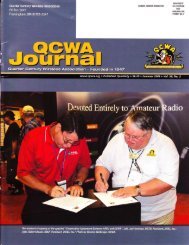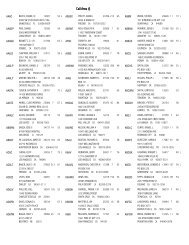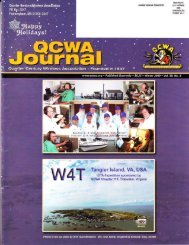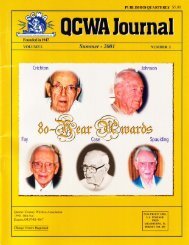Create successful ePaper yourself
Turn your PDF publications into a flip-book with our unique Google optimized e-Paper software.
Field Day in CT and High Speed Code!<br />
A Journalistic History of The Life and Times in Amateur Radio of George Hart, Wl NJM<br />
by George Hart, Wl NJM<br />
e're not through with Field Day just yet. When the<br />
rules changed to allow a 27-hour instead of a 24hour<br />
period of on-the-air operation we opted to<br />
operate the entire 27-hour period, as we had operated the 24hour<br />
period previously. The only restriction was that lhe 2-/<br />
hours included set-up time. Where previously we had arrived at<br />
the site at least a day ahead of time and some of us two or<br />
even three days ahead, now we could not start setting up at<br />
the site before 2 p.m. Saturday; however, if we followed this<br />
rule, we could start operating as soon as we could get a rig on<br />
the air. So a totally new approach was in order. The plan was<br />
to be prepared to set up a "temporary" position with a "temporary"<br />
antenna and start operating almost immediately at 2<br />
p.m. while the rest of the crew would be setting up the "permanent"<br />
facilities according to a plan that would get us fully<br />
operational within an hour, thus giving us more than two hours<br />
more operating time than those who took their time getting<br />
set up and were restricted 1o 24 hours. The idea was to<br />
encourage amateurs to have equipment prepared to go into<br />
operation as soon as possible after an emergency communication<br />
situation occurs. I use the above words in quotes because<br />
everything about Field Day operation is temporary.<br />
We would gather on Saturday morning at Dick Smith s<br />
(W1FTX) place, which was only about a mile from the Field Day<br />
site, and start getting our equipment ready and loaded into<br />
cars. When everything was ready and everybody fully instructed<br />
we would proceed to the FD site in a caravan, arrive there perhaps<br />
an hour before the 2 p.m. start. Someone with a receiver<br />
in his car would monitor WWV so the drill would start on the<br />
second. Then we would walk around the building, decide<br />
where and how we would erect the antennas, how to bring<br />
feedlines into the building, where to place the "temporary"<br />
operating position and its antenna, where to place the generator,<br />
etc. Everything was talk and planning at this point. No<br />
actual installation activity could begin until 2 p.m. By 1:55<br />
everyone would be gathered around the loaded vehicles listening<br />
to the countdown.<br />
When the long beep from WWV would signal exactly 2 p.m.<br />
we would "charge" the site carrying equipment, get the "temporary"<br />
position set up and on the air, start putting up antennas,<br />
installing "permanent" operating positions. When the first<br />
"permanent" position started operating we stopped using the<br />
"temporary" position and its personnel went about assisting in<br />
getting the other "permanent" positions "radioactive." We<br />
called it the "Chinese fire drill. " Everything was hurry, hurry,<br />
hurry, often with considerable confusion, until all the "permanent"<br />
positions were set up and active. Then things started to<br />
settle down as operators started their scheduled shifts while<br />
others lounged around, shot the bull, drank beer or occasional-<br />
ly stronger liquids, and the FD chairman prowled around checking<br />
operations, notifying persons of their shifts, posting hourly<br />
results and progress compared to previous years, the chef (Joe<br />
Moskey or Tony Dorbuck usually, but others occasionally had a<br />
shot at it, including myself) banging pots and pans in the<br />
kitchen getting ready to feed the crew. All positions continued<br />
operating the full 24+ hours. Occasionally if a piece of equipment<br />
failed it was quickly yanked and replaced. lt was a highintensity<br />
operation. The FD chairman would decide on bandchanges<br />
or mode changes whenever operation on a particular<br />
band or mode would begin to slacken; but all positions would<br />
remain in operation full blast until 5 p.m. Sunday.<br />
On our first "Chinese fire drill" we had the temporary position<br />
operational within 30 minutes, all permanent positions in operation<br />
within 1-1/2 hours. ln subsequent years we improved on<br />
this by having one or more of the cars equipped with portable<br />
rigs and operational immediately at 2 p.m. so that more of the<br />
people could be used to get the permanent positions operational;<br />
so temporary operation began immediately at 2 p.m.<br />
and full FD operation started within 45 minutes. ldon't have<br />
the exact figures without detailed research, but we must have<br />
won our class at least 5 times from i951 through 'l 980 and<br />
placed within the top ten a majority of those years. We also<br />
challenged several club groups elsewhere in the country who<br />
had bested us or placed near us - challenged them to a private<br />
competition with agreed-upon rules outside the rest of the<br />
field. To the CWA, the object was winning. Preparedness for<br />
operating in emergencies was secondary. Also, there was very<br />
little picnic-type activity. Women and children were not a part<br />
of our FD, although occasionally some would show up. We<br />
wanted nothing to distract from our chance of winning.<br />
At Haddam Neck, Dennis Hill and some of the other places<br />
from which we operated we used gasoline-powered generators<br />
as a power source. At no time did we ever use the commercial<br />
electric lines, even when available, as they were in most places.<br />
The generators were usually borrowed, sometimes rented, and<br />
at one time the club owned a second-hand generator, which<br />
never worked well. The biggest multiplier was for not using<br />
commercral power at the site for any purpose before, during or<br />
after the FD operating period (from 5 p.m. Saturday to 5 p.m.<br />
Sunday, later from 2 p.m. Saturday to 5 p.m. Sunday). A lesser<br />
multiplier could be applied if no commercial power was used<br />
just during the FD period. Other multipliers were available for<br />
other simulations of emergency conditions. The rules were very<br />
complicated, often poorly written-up and therefore sublect to<br />
interpretation in loudly voiced debates. I always contended that<br />
it was impossible to use the biggest power-source multiplier if<br />
the site used had commercial power available, but the rest of<br />
CWA interpreted it differently and always claimed this multipli-<br />
44 QCWA Journal . Winter 2Oa7 . \ ^Aw.qcwa.org



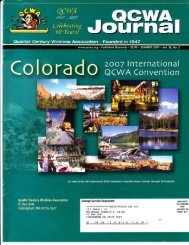
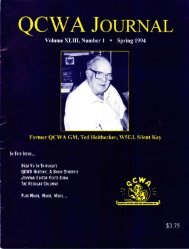
![11{J hI EfifSIt]E I]E - Quarter Century Wireless Association](https://img.yumpu.com/11816560/1/190x245/11j-hi-efifsite-ie-quarter-century-wireless-association.jpg?quality=85)
